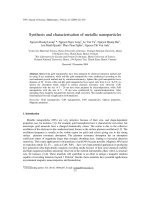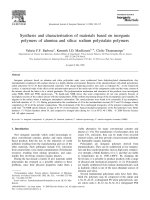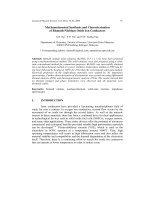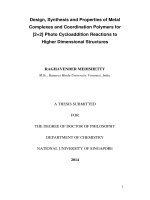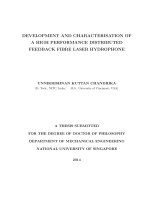Synthesis and characterisation of electrical conducting polymers co polymers based on omega functionalised 3 alkylthiophenes 1
Bạn đang xem bản rút gọn của tài liệu. Xem và tải ngay bản đầy đủ của tài liệu tại đây (256.46 KB, 47 trang )
Synthesis and Characterisation of Electrical Conducting
Polymers/co
-
polymers Based on
-
Functionalised
3-A
lkylthiophenes
Ma YiFei
National University of Singapore
2004
Synthesis and Characterisation of Electrical Conducting
Polymers/co
-
polymers
Based on
-
Functionalised
3-A
lkylthiophenes
Ma YiFei
(B. Sc. (Hons.) NUS)
A THESIS SUBMITTED
FOR THE DEGREE OF DOCTOR OF PHILOSOPHY OF
SCIENCE
DEPARTMENT OF CHEMISTRY
NATIONAL UNIVERSITY OF SINGAPORE
2004
I
II
ACKNOWLEDGEMENTS
I would like to express my sincere appreciation to Associate Professor Ng Siu
Choon for his constant
guid
ance
and encouragement throughout the course of this
project.
I would like to extend my heartfelt gratitude to Professor Hardy Chan for
his invaluable advice, patience and unwavering support. Without the help from
Professor Chan, I would not have been able
to complete my studies.
I would also like to thank the members of Functional Polymer Group for their
excellent support and stimulating advice, especially to Mr. Wang Yeang Chyn for
his help and friendship. Many thanks to staff and technicians in Surface
Science
Laboratory, Honours Laboratory and Central Laboratory for their assistance.
II
Table of Contents
Summary
List of schemes
List of figures
List of tables
Chapter 1
Introduction
1.
Overview of common conducting polymers
2
2.
Brief introduction on the condu
cting mechanism
5
3.
Heterocyclic conducting polymers
10
4.
Polythiophene copolymers
15
5.
Scope of thesis
17
6.
Analytic
al
method
20
References
28
Chapter 2
Syntheses and characterisation of poly[3-( -
bromoalkyl)]thiophenes
1.
Introduction
1.1
Conducting p
olythiophene
32
1.2
Functionalised poly(3
-alkylthiophene)
33
1.3
Scope of the work in this chapter
35
2.
Experiment
2.1 Monomer syntheses
37
2.2 Polymerisation
39
3.
Results and Discussion
III
3.1 Experiments on different protecting groups
40
3.2
Structural characterisation of synthesised monomers
41
3.3 Physical properties of polymers
43
3.4
FT
-
IR
and
1
H NMR characterisation
45
3.5 Electrical conductivity of the doped polymers
49
3.6 UV
-V
is and fluorescence spectroscopy
50
3.7 Thermal stabili
ty of the neutral polymers
53
3.8 Polymer surface studies
56
3.9 Attempts to further functionalise the
-
bromo moiety on the
polymers
58
4.
Conclusion
59
5.
Experimental
61
References
74
Chapter 3
Graft copolymers of polythiophene and polystyren
e based
on 3
-{ -
[1
-
(p
-
vinylphenyl)]hexyl}thiophene
1.
Introduction
79
2.
Experiment
2.1 Monomer synthesis
81
2.2 Copolymer syntheses
83
3.
Results and Discussion
3.1 Monomer synthesis and characterisation
89
3.2 Copolymer characterisation
93
IV
4.
Conclusi
on
122
5.
Experimental
123
Reference
s 128
Chaper 4
Graft copolymers of polythiophene and PMMA
1.
Introduction
131
2.
Experiment
2.1 Monomer synthesis
133
2.2 Copolymer syntheses
138
3.
Result and Discussion
3.1 Monomer synthesis and characterisation
140
3.2 Copolymer characterisation
147
4.
Conclusion
173
5.
Experimental
174
Reference
s 1
79
Chapter 5
Conclusion and suggestions for future work
1.
Summary of the project
182
2.
Comparison between the two series of copolymers
185
3.
Suggestion
s
for future work
189
Appendix
List of main compounds
report
ed in this thesis
19
1
V
Summary
This thesis reports the syntheses and characterisation of three series of novel electrical
conducting polymers
/copolymer
s based on
fuctionalised 3-
alkylthiophe
ne monomers.
The aim is to study the viability of grafting commodity polymers with polythiophene
through an alkyl linkage. These polymers are potentially useful as anti
-
static materials.
1.
Poly[3
-( -
bromoalkyl)thiophene]
n = 4 (
p
THC4Br)
= 6 (p
THC6Br)
= 8 (p
THC8Br)
= 10 (
p
THC10Br)
= 12 (p
THC12Br)
Initially
, a series of monomers, 3-( -bromoalkyl)thiophenes, were synthesised
and characterised based on reported methods. Subsequent oxidative
polymerisation yielded a series of corresponding polymers, which were fully
characterised. These polymers were soluble in polar solvent such as chloroform
and had conductivit
ies
comparable to th
ose
of poly(3-
alkylthiophenes).
However,
attempts to carry out Grignard r
eaction
s using these polymers in order to further
functionalise t
hem
were unsuccessful. Hence 3-( -bromoalkyl)thiophenes were
further functionalised in order to obtain graft copolymers of polythiophene and
commodity polymers.
2.
Graft copolymers of polythiophene and polystyrene (PS) based on 3-{ -
[1
-(p-
vinylphenyl)]hexyl}
thiophene
S
(CH
2
)
n
Br
m
VI
In this approach, further functionalisation of 3-( -
bromoalkyl)thiophenes result
ed
in a novel monomer, 3
-{ -
[1
-(p-
vinylphenyl)]hexyl}thiophene.
This compound
was
polymerised in two steps: first,
2,2’
-
azobis(2
-
methylpropionitrile) (
AIBN
) was used as
an
initiator to polymerise the vinyl
phenyl group. S
ubsequent
ly
an
oxidative polymerisation step produced
a
polythiophene structure. However, the copolymer
formed was not soluble and had
poor conductivity. On the other hand, the monomer
was
co
polyme
rised with
styrene in different ratios. When the result
ant
copolymers were subjected to
oxidative copolymerisation with thiophene or 3-alkylthiophene derivatives, a
series of grafted copolymers of polystyrene and polythiophene with alkyl chain
linkage
s were obtained. These copolymers have improved conductivity and
processibility. A close look at the characterisation results reveal
ed
that the
structure of the copolymers played an important role in determining the
ir
propert
ies
.
3.
Polymethyl methacrylate (
PMMA
)
and Poly(3
-
alkyl)thiophene co
-
polymer
A novel monomer, 11-
thiophen
-3-
yl
-
undec
-1-
en
-3-one, w
as
synthesised and
characterised.
S
C
6
H
1
2
P
h
VII
Once again,
a
direct two
-
step co
-
polymerisation
reaction
of this monomer resulted
in a polymer that was not soluble and with poor conductivity. Introducing methyl
methacrylate
MMA and thiophene or 3-alkylthiophene into the copolymer matrix
using the process described above produced a series of grafted copolymers that
have improved processibility and conductivity.
The results from this work demonstrated the viable route of forming graft
copolymer
s of polythiophene and PS
or
PMMA via
functionalised 3-
alkylthiophenes. Their properties largely depend on the backbone structure of the
polymers. Soluble and conductive copolymers have been obtained by varying the
polymer
structure. These materials are potentially useful as anti-
static
plastic
products
.
S
CH
2
8
O
VIII
List of Schemes:
Scheme 2.1
Monomer synthesis. Reagents and conditions: (i) KOH/MeOH, acetone,
reflux; (ii) Mg, I
2
, anhydrous e
th
er, reflux; (iii) Ni(dppp)Cl
2
, anhydrous
Ether; (iv) HBr/Ac
2
O, 100
C
Scheme 3.1
Synthesis of the monomer 3
-{ -
[1
-
(p
-
vinylphenyl)]hexyl}thiophene
Scheme 3.2
Direct two
-
step polymerisation to afford
copolymer
Graft 100
Scheme 3.3
Polymerisation of styrene and monomer in the ratio of 1:1 and 5:1
afford
ed
3b
and
3c
respectively, which can be further polymerised to give
copolymers Graft
21 and
Graft
51
Scheme 3.4
Polymerisation of styrene and monomer 3 in the ratio of 10:1
produced
3d
, which can be further co-
po
lymerised with 3-octylthiophene and
thiophene
Scheme 4.1
Synthesis of
m
onomer
5
Scheme 4.2
Possible mechanism
s
for the formation of
4
as the major product
Scheme 4.3
Synthes
i
s of
g
raft copolymer
7 from monomer 5
Scheme 4.4
Synthes
i
s of graft copolymer
9
Sc
heme 4.5
Syntheses of graft copolymer
s
10 and
11
IX
List of Figures:
Fig. 1.1
Proposed conducting unit of polyacetylene. Soliton may be neutral (radical),
positive (carboc
ation), or negative (carbanion)
Fig. 1.2
The formation of polaron
and bipolaron in po
lythiophene
Fig.
1.3
Interchain hopping of bipolaron according to Bredas et al.
Fig.
2.1
Overlaid FT-IR spectra of all monomers. From top to bottom: THC4Br,
THC6B
r, THC8Br, THC10Br, and THC12Br
Fig
.
2.2
FT-IR spectra of polymers before and after soxh
let
extraction (doped and
undoped
) From top to bottom: (a) undoped pTHC4Br; (b) pTHC6Br; (c)
pTHC1
0
Br; (d) doped pTHC6Br and (e) 3
-( -
bromohexyl)thiophene
Fig.
2.3
NMR spectrum of pTHC6Br
Fig. 2.4
TGA curve of pTHC6Br in air
Fig. 2.
5
Deconvolution of C1s environ
ment in XPS spectrum of pTHC4Br
Fig 3.1
1
H NMR spectrum of monomer
3
Fig 3.2
13
C NMR spectrum of monomer 3
Fig. 3.3
NMR of precursor polymer
3a
Fig. 3.4
NMR spectrum of precursor copolymer
3c
Fig. 3.5
NMR spectrum of the resulted copolymer from 3-( -
bromo
hexyl)thiophene,
monomer
3
and styrene in 1:1:10 mole ratio
Fig. 3.6
1
H NMR spectrum of
the
polymer blend of PS and poly(3-octylthiophene)
Fig. 3.7
1
H NMR spectrum of
grafted copolymer 4
Fig. 3.8
1
H NMR spectrum of
g
rafted copolymer of PS and polythiophene
(
5)
Fig. 3.9
IR spectra of
copolymers
4
,
5
and
the copolymer blend
X
Fig. 3.10
IR spectrum of
copolymer
Graft
100
Fig. 3.11
XPS spectrum of
copolymer
4
Fig. 3.12
C 1s core level of XPS spectrum of
copolymer
5
Fig. 3.13
C 1s core level of XPS spectrum of
cop
olymer
Graft
100
Fig. 3.14
S 2p core level XPS spectrum of
copolymer
4
Fig. 3.15
XRD
spectrum
of
copolymer
Graft
100
Fig. 3.16
XRD
spectrum
of copolymer
4
Fig. 3.17
XRD
spectrum
of copolymer
5
Fig. 3.18
Thermal degradation pattern for
copolymers
(from top to bottom)
Graft
21
,
Graft
51 and
Graft
100
Fig. 3.19
TGA plot for copolymer
4
in air
Fig. 3.20
Overla
id
DSC plots for
copolymers
(from top to bottom) 4
(1),
Graft 100
(2)
and
5
(3).
Fig. 3.21
Illustration of possible structure
s
of
copolymers Graft
100
and
4
Fig. 4.1
1
H NMR of 3
-
(unde
-
10
-
enyl)thiophene
(3)
Fig. 4.2
1
H NMR of 11
-
thiophen
-3-
yl
-
undec
-1-
en
-3-
ol
(4)
Fig. 4.3
13
C NMR spectrum of 11
-
thiophen
-3-
yl
-
undec
-1-
en
-3-
ol
(4)
Fig. 4.4
1
H NMR spectrum of 11
-
thiophen
-3-
yl
-
undec
-1-
en
-3-
one
(5)
Fig. 4.5
13
C NMR sp
ectrum of 11
-
thiophen
-3-
yl
-
undec
-1-
en
-3-
one
(5)
Fig. 4.6
1
H NMR spectrum of 11
-
thiophen
-3-
yl
-
undec
-3-
en
-2-
one
Fig. 4.7
1
H NMR spectrum of copolymer
10
Fig. 4.8 Overlaid IR spectra of
copolymers
7
,
9
,
10 and
11
Fig. 4.9
XPS
spectrum
of copolymer
9
XI
Fig. 4.10
C1s core level of XPS spectrum of copolymer
11
Fig. 4.11
C1s core level of
copolymer
7
Fig. 4.12
S 2p core level data of
copolymer
10
Fig. 4.13
XRD
spectrum
of copolymer
7
Fig. 4.14
XRD
spectrum
of
copolymer
9
Fig. 4.15
XRD
spectrum
of copolymer
10
Fig. 4
.16
XRD
spectrum
of copolymer
11
Fig. 4.17
TGA plot of copolymer
7
in N
2
environment
Fig. 4.18
TGA plot of copolymer
10
in N
2
Fig. 4.19
TGA plot of copolymer
11
in N
2
Fig. 4.20
Stacked TGA plots for copolymers
7,
9, 10 and 11
(the
% weight change is
only
indicative of the scale)
Fig. 4.21
SEM image of
(from top to bottom, left to right)
copolymers
7, 9, 10
and
11
Fig. 5.1
Illustration of possible structures of copolymer
s
formed from 100% monomers
A: commodity polymer backbone TH: thiophene/3-
alkylthiophene
XII
List of tables:
Table 1.1
Conductivities of
m
etals and
d
oped
p
olymers
Table2.1
Summarised data of polymers formed
Table2.2
Optical properties of the polymer
Table2.3
Sensitivity factor of some common elements
Table 2.4
Atomic ratio results for all p
ol
ymers in their undoped states
Table2.5
Percentage yield
s
of Br
-
(CH
2
)
n
-
OPhOMe and their melting point
s
Table2.6
Percentage yields of 3-[ -
(p
-methoxyphenoxy)alkyl]thiophenes and their
melting points
Table2.7
P
ercentage yield
s
of 3
-( -
bromoalkyl)thiophenes an
d their boiling points
Table 2.8
P
ercentage yield
s
of
p
oly
-3-( -
bromoalkyl)thiophenes
Table3.1
Elemental analyses results of grafted copolymers
Table 3.2
Elemental content of
copolymers
4
,
5
and
Graft
1
00
determined by XPS
Table 3.3
C 1s of XPS spectrum da
ta of
copolymer
5
Table3.4
Summarised 2
peaks of
copolymers
Graft
100
,
4
and
5
Table 3.5
Summarised
t
hermalgravimetric analyses results
Table3.6
GPC analyses, conductivity measurements and UV-Vis results for copolymers
formed
Table4.1
Elemental analyses r
esults of the graft copolymers
Table4.2
Summary of XPS elemental content of the copolymers
Table 4.3
C1s core level data of
copolymer
11
Table 4.4
C1s core level data of
copolymer
7
Table 4.5
C1s core level data of
copolymer
9
XIII
Table 4.6
C1s core level dat
a of
copolymer
10
Table 4.7
Summary of the 2
peaks of the copolymers
7
,
9
,
10
,
11
Table
4.8
Therm
o
gravimetric stud
ies
of the graft copolymers
7
,
9
,
10
,
11
Table
4.9
Thermal analys
e
s results for copolymers
7, 9, 10
and
11
Table
4.10
Atomic ratio
of copolym
ers
7
,
9
,
10
,
11
calculated based on EDX spectra
Table
4.11
Maximum conductivity achieved by the copolymers
7
,
9
, 10
,
11
Chapter 1
Introduction
2
1.
Overview of common conducting polymers
Most
commodity
polymers such as polyethylene, polystyrene and poly(
vinyl
chloride
) are insulators. Some conduct electricity to a certain extent,
e.g.
, poly(N-
vinyl carbazole) is used in the photocopying industry due to its photo conducting
properties [1].
In the 1970s it was found that certain polymers especially poly(sulfur nitride) [2]
and polyacetylene [3] are highly conducting when doped with certain additives
(dopants).
As a result of this important finding, major research efforts have been initiated
over the next three decades to explore these new mate
rials’
conducting
mechanisms and application potential.
Factors such as method of synthesis, type and concentration of dopant and
polymer morphology affect the conductivity of the polymers. Although the more
stable polymers such as those heterocyclic conducting polymers may not be as
conductive as polyacetylene, nonetheless, the amount of conductivity is
considered acceptable for commercial development.
poly(N-vinyl carbazole)
N
n
S N
poly(sulfur nitride)
CH CH
polyacetylene
3
A comparison of conductivity between doped polymers and selected metals is
illustrated in table 1.1 [4].
Table 1.1
Conductivities of
m
etals and
d
oped
p
olymers
Material
Conductivity (S/
cm
)
Copper
5.8x10
5
Gold
4.1x10
5
Polyacetylene
10
3
-
10
5
Polyfuran
10
2
Poly(sulfur nitride)
10
3
-
10
4
Poly(
p-
phenylene)
10
3
Poly(
p-
phenylenevinylene)
10
3
Polyaniline
10
2
-10
3
Polypyrrole
10
2
-
10
3
Polythiophene
10
2
P
olyacetylene
has been the most widely studied conducting polymer
.
However,
the polymer has limited commercial value due to its instability when exposed to
moisture and air. Consequently, research attention has diverted to other more
stable conducting polymers such as polyaniline [5] in various oxidation states,
polypyrrole [6], polythiophene [7], poly(p-
phenylene
) [8] and poly(p-
phenylenevinylene
)
[9] as well as their derivatives.
4
In order to elevate the co
nductivity of these polymers to practical levels, doping is
carried out. AsF
5
and I
2
are examples of dopants that are
ionised
to AsF
6
-
and I
3
-
respectively upon complexation. An unusual dopant is HCl, which was employed
in the doping of polyaniline [10]. Apart from chemical synthesis, conducting
polymers may also be formed from their monomer solutions via electro chemical
polymerisation in a
reaction
cell as a continuous film [11]. In this method, dopant
ions are introduced directly from the monomer solutio
n.
Conducting polymers generally have densities of around 1 g/cm
3
, which is much
lower than that of metals (
e.g.,
8.92 g/cm
3
for copper; 19.3 g/cm
3
for gold). Many
areas of application have been developed for these polymers [12].
Taking
advantage of this and other unique properties of these polymers, advanced
technological material from lightweight batteries, sensors, thin film transistors,
light emitting diodes (LEDs), solar cells and antistatic material to solid
electrolytes are
envisaged
. In recent years, conducting oligomers have also drawn
much attention [13, 14]. There have been reports on developing ‘molecular wires’
NH
polyaniline
CH
poly(p-phenylenevinylene)
CH
N
H
polypyrrole
S
polythiophene
poly(p-phenylene)
5
which consist of conducting polymeric material that bridge metal surfaces for use
in molecular scale electronic devices [15, 16].
The
research effort in the last three decades have solved many previously
unanswered questions and at the same time, paved way for new challenges. With
the amount of growing interest, one can certainly hope that the full potential of
conducting polymers
can
be
realised.
2.
Brief introduction
to
the conducting mechanism
Conductivity ( ) has units of siemens per centimetre (S/cm). Usually materials
are deemed as insulators when their conductivity are below 10
-8
S/cm,
semiconductors when their conductivities are between 10
-7
and 1 S/cm and
conductors when they have conductivities higher than 100 S/cm. Most
conducting polymers in their neutral states are insulators or weak semiconductors.
They only achieve high conductivity after being ‘doped’ by either an oxidisin
g
[17] or a reducing
[18]
dopant. It is generally believed that the so-called ‘soliton’
or ‘polaron’ and ‘bipolaron’ structure is
/are
formed as a result of a redox reaction.
Polyacetylene will be used here to demonstrate the concept of solitons and
polyth
iophene will be used to explain the concept of polaron and bipolaron.
Neutral cis polyacetylene is an insulator (
= 1.7 x 10
-
9
S/cm), while its neutral
trans isomer is a weak semiconductor (
= 4.4 x 10
-5
S/cm). Upon doping, either
cationic radicals or a
nionic radicals are formed, depending on the dopant used:
6
These redox processes generate charge transfer complex
es
on the polymer
backbone called soliton, which is responsible for the intramolecular conductivity.
Further, it seems that doping rearranges the cis isomer to the trans configuration
as well.
Fig. 1.1
Proposed conducting unit of polyacetylene. Soliton may be neutral
(radical), positive (carbocation), or negative (carbanion)
However, when the soliton extends along the polymer backbone,
energy
accumulates due to double bond stretching and single bond constriction. This
build
-up of energy will eventually outweigh the stabilisation energy that arises
from delocalisation. Therefore, solitons can only be elongated to a certain extent.
Conduc
tivity of the bulk polyacetylene though, depends not only on the solitons’
length and intramolecul
ar
conductivity. Electrons moving intermolecularly across
solitons also contribute to conductivity. The conduction thus generated is highly
dependent on the p
olymer’s crystalline structure. For example, the conductivity of
polyacetylene film can be increased to 10
5
S/cm level by properly orienting the
polymer chains
[3].
Soliton
CH CH
2
3
I
2
2
CH
CH
2
I
3
-
+ +
CH CH
CH
CH
+ +
Na Na
+
7
From the discussion on the conducting mechanisms of polyacetylene, we can
conclude that there are three important factors for a conducting polymer to
achieve high conductivity: doping, backbone conjugation and polymer
morphology. This point is
reiterated
below where the conducting mechanism of
polythiophene is discussed.
Upon doping polythiophene, polarons and bipolarons are formed [19]. A polaron
is a radical cation that stabilises itself by polarising the medium around it. Each
polymer segment containing polaron can be further oxidised to form
two
polarons
or a bipolaron. Fig. 1.2 illustrates
the
formation of polaron and bipolaron.
S
S
S
S
S
S
SSS
S
+
+
( )
[
]
(
)
n
n
n
)
(
]
[
+
S
SSS
S
S
S
S
.
A
A
-
Polaron
A
A
-
2
Bipolaron
Fig. 1.2
The formation of polaron and bipolaron in polythiophene
A bipolaron usually stretches from 1 to 6 carbon atoms and has a structural
deformation associated with it. For example, the rearrangement of the arylene
rings form aromatic to quinoidal configuration, thus maintaining planarity along
this chain and moving in tandem as a pair. Movement of a polaron or a bipolaron
8
via rearrangement of the double and single bonds in the conjugated polymer
backbone ac
counts for conductivity at the intra
-
molecular level.
The interchain transport mechanism for polymers with non-degenerate ground
states was best modelled by Bredas
et al.
[20, 21]. Quantum-
chemical calculations
revealed
that
the
removal of an electron out of a polyarylene system like
polyphenylene [22], polypyrrole [23]
or
polythiophene [24] leads to the formation
of polaron and associated quinoid
-
like geometry (Fig. 1.2) over four to five rings.
The quinoid structure has a lower ionisation potential and
a larger electron affinity
than the benzenoid structure. This lowering of the ionisation energy more than
compensate the increase
in
total electronic energy due to lattice deformation
around the polaron, thus energetically favouring the formation of polaron. The
difference in energy corresponds to the polaron binding energy found to be about
0.12 eV in polypyrrole, 0.2 eV in polythiophene and 0.03 eV in poly(p-
phenylene)
[22
-
24]
.
Further oxidation results in the formation of bi
-
polaron
a
s shown
in Fig 1.
2
above.
At high doping levels, electrical transport is effected by
bi
polaron hopping
(tunneling).
Interchain hopping is believed to be the rate-determining step for the
observed macroscopic conductivity. Fig. 1.3 illustrates interchain hopping of
bipolar
on according to Bredas et al.
[20, 21]
.
9
n
)
(
S
S S
S
S
S
n
)
(
+
+
S
SSS
S
S
S
S
Fig.
1.3
Interchain hopping of bipolaron according to Bredas et al.
Further oxidation will lead to a phenomen
on
called “transport into more extended
conducting regions” [20], which is the process in which electricity is conducted
through a two-phase system, only one of which is conducting, depending on the
concentration of that phase. The non
-
conducting barriers may be undoped regions,
interparticle contacts or molecular defects, for example,
unconjugated chains.
The
size of the conducting clusters increases with the doping level until a kind of
percolation threshold is reached and the clusters are sufficiently close to form a
quasi continuum. Conducti
on
occurs by charge carriers shuttling between one
conducting cluster to another along the path of least resistance. As doping levels
reach near saturation in the matrix, “conducting islands” cover all acceptable sites
of the sample. Due to intrinsic defects, some sites will not be conducting. In such
a disordered system whereby there are large conducting regimes separated by
small insulating barriers, a novel mechanism: fluctuation-induced tunneling has
been proposed by Sheng[25] which explains temperature and field dependence on
conductivity
.
